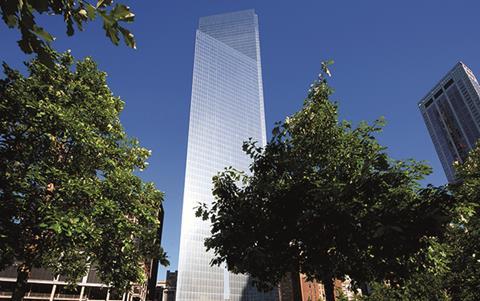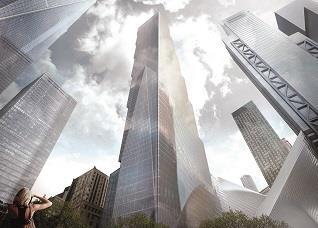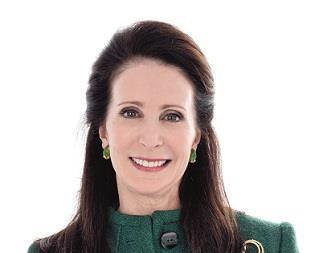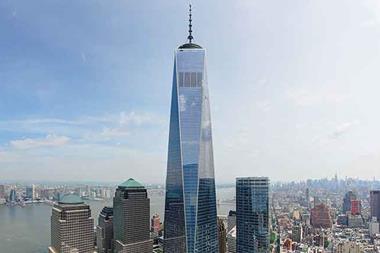In the final of our Summer Legends series, we look back to Steve Cuozzo’s interview with the man who twice crafted New York’s skyline, Larry Silverstein.

A New York state of mind
World Trade Center developer Larry Silverstein adheres to a principle that has guided his epic career since he bought his first small building for less than $1m in 1957.
“People around you can tell you what they think you should do,” he says in an exclusive interview for Property Week.
“They can say what you’re doing is wrong. But it’s not their building, their money, their investment. It’s my risk, my capital, my energy - so I’ll do what I think is right.”
It is an attitude that has made him New York City’s most lightning-rod developer in recent years. Until history intervened on September 11, 2001, his career was largely devoid of public drama.
Even now, the privately held Silverstein Properties’ 10m sq ft of commercial and residential holdings are considerably smaller in scale than those of some other real estate moguls.
Emotional punch of World Trade Center
‘Ground Zero’, for all its resonance, is smaller than the mini-city Hudson Yards, which Related Companies is creating above a rail yard on the far West Side.
But no development packs the emotional punch of the World Trade Center.
“It’s been a long, interesting, challenging road. I’d say the last 15 years of my life have been transformative for me,” Silverstein says with understatement.
No other developer was charged with “the right and the obligation”, as Silverstein calls it, to recreate a 14m sq ft office complex at the site of the terrorist attack where 2,753 innocent victims died - in a singularly difficult location on which to build and in the face of withering political and commercial headwinds.
But build Silverstein has, with the World Trade Center complex once again providing the focal point to the downtown skyline. So just how did Silverstein marshal the resolve and financial reserves to face down critics to deliver a new World Trade Center?

Keeping it local
For all his worldwide name recognition, Silverstein’s focus has always been largely local. His US career has been mainly in Manhattan, where he has weathered the notoriously cyclical industry downturns. His only current overseas role is a partnership with the late Polish entrepreneur Jan Kulczyk’s Kulczyk Investment to develop properties in Warsaw and central Europe.
For Silverstein, New York remains the centre of the world. The much-touted New York-London rivalry for commercial supremacy doesn’t faze him. “Trillions of dollars in capital is coming to New York from different parts of the world,” he says. “They want the safe haven. What’s their first stop? New York. What do they want in New York? Hard assets. They are buying our buildings, condos, anything they can get their hands on, driving cap rates to extraordinarily low levels.”
Silverstein recently warned of overbuilding in the luxury condo market, but he has no such fears of office sector saturation. He has no qualms that Manhattan is bringing online about 10m sq ft of speculative, newly minted space at the World Trade Center, Hudson Yards and several other locations.
“Appreciate the fact that 50% of [existing Manhattan] buildings are 60 years of age, ancient and totally inadequate from the tech and environmental standpoint for the way major corporations need to function,” he reasons.

“This is why we have movement of major corporate users into the new buildings. And compared with our 400m sq ft, they are a tiny fraction.”
What’s more, he says, New York developers no longer have to rely on the same old industries to take space.
“We’re seeing amazing growth in technology, science and healthcare.
“Where you see diminution is in banking, which traditionally drove the market. It is no longer the New York driver, especially downtown, which has drawn advertising, tech and creative companies. When you see ping-pong tables in the reception areas, you know something [new] is going on,” he chuckles.
Silverstein has been aided and abetted by his involvement in some pretty savvy partnerships over the years, including a joint venture with the California State Teachers’ Retirement System (CalSTRS) in 2006 to buy several Midtown office towers including 1177 Sixth Avenue at 45th Street. His current partners include CalSTRS, CBRE Investors, Dune Real Estate Partners, Elad Group, Fisher Brothers, Four Seasons Hotels and Resorts and Wells Fargo.
But Silverstein is always at the throttle, never more so than at the World Trade Center. The Brooklyn-born developer has a will as steely as Manhattan schist, and he needed to draw on every last reserve to see the job through.
Passion for New York
His passion for the landmark, formerly known as the Twin Towers, was apparent before he bought it. In January 2001, when I first met him, he seemed an also-ran for the 99-year leasehold, which the land-owning Port Authority of New York and New Jersey had put on the market. How could he top bids by publicly traded giants Vornado Realty Trust and, in partnership, Boston Properties and Brookfield Properties?
But Silverstein’s determination was clear even then. “We’re lusting for the World Trade Center, the prize of all prizes,” he told me, giving no hint that he’d been seriously injured and nearly killed by a hit-and-run driver the week before and had gone without painkillers, which he thought clouded his concentration.
His focus paid off. When Vornado wearied of dealing with the Port Authority, Silverstein brought in New York real estate players Lloyd Goldman and the Cayre family as investment partners to put in the winning $3.2bn bid.
Any sense of jubilation proved short-lived, however. Silverstein signed the Trade Center lease two months before 9/11. He lost numerous colleagues and friends in the attack and, for a second time, narrowly escaped death himself when a doctor’s appointment kept him from a morning meeting in the towers.
Through the chaotic years of confused planning that followed, he fought with insurance companies, the Port Authority and politicians who wanted Ground Zero to be used for housing, not to mention master site planner Daniel Libeskind. Some newspapers wanted him booted off the project.

The battles with the Port Authority were particularly debilitating, although Silverstein says their differences have been resolved. “We’ve been working together very successfully for the past five or six years,” he says.
“Fortunately, we put the haggling behind us I think in 2010, and our relationship now is a very good one.”
He prefers not to dwell on the nine years prior, when he was paying the authority $10m in annual ground rent on buildings that no longer existed. Many blamed Silverstein for slow progress, but “we couldn’t build a thing until the site was excavated”, he points out. The authority ended up paying him $20m in fines for an almost four-year delay.
At last, after 15 years of struggle - “I never expected it to take so long,” he says as he approaches his 85th birthday - he can claim victory. The last tower planned for the site, 2 World Trade Center, a 2.8m sq ft giant, remains unbuilt, but Silverstein has developed and owns three magnificent new skyscrapers: chronologically numbers 7, 4 and 3 World Trade Center.
Crowning glory
Designed respectively by David Childs, Fumihiko Maki and Richard Rogers, the towers add a glistening, late-in-life crown to Silverstein’s portfolio, which had not previously enjoyed much architectural distinction. He admits that the first 7 World Trade, which opened in 1987, was a lemon. The building was his only pre-9/11 project to bear the World Trade Center name and was a masonry-wrapped monster across the street from the main 16-acre complex. “I was intent on building [it] as inexpensively as I could,” he explains.
When Silverstein put up the gleaming successor to 7 World Trade entirely on spec, detractors including then New York City mayor Michael Bloomberg griped that he was demanding too high a rent. But Silverstein’s vindication was sweet: the tower opened empty in 2006 and was 100% leased within six years. Towers 4 and 3 (the latter not yet finished) are already more than 50% leased, to companies including tech and media firms that didn’t exist in 2001, such as Media Math and GroupM.
As for the “iconic” 1,776ft-tall 1 World Trade Center, previously called the Freedom Tower, Silverstein began construction on the project before yielding it to the Port Authority (which has since partnered with the Durst Organization) as part of a complicated 2006 renegotiation.
“We had to come to an understanding,” he says now without regret. “I’ll tell you, if you look at 1 World Trade Center, now home to Condé Nast, I think it turned out very well, very handsome, and it will soon be fully leased.”
The gnawing missing link remains 2 World Trade Center. “We do expect to put a deal together for the tower by 2017 and I believe it will be finished in 2021, or at the latest 2022,” he says.

A year ago, Rupert Murdoch’s 21st Century Fox and News Corporation signed a non-binding letter of intent to occupy 1.6m sq ft. However, in January the companies decided not to pursue the project over cost and fears of corporate disruption.
Even when a tenant comes along, bankrolling the $4bn 2 World Trade might be harder than it was for 3 World Trade. A MUNI market downturn caused Silverstein to postpone full construction even after he had signed GroupM as an anchor tenant. It wasn’t fully green-lit until October 2014, when he exploited a bond market ripening to finally place, via Goldman Sachs, $1.1bn in tax-exempt Liberty Bonds.
Now, his total $3bn in Liberty Bonds is exhausted and last summer he tapped HFF to seek investors, probably a pension fund or sovereign wealth fund, for a stake in 2 World Trade via an equity partnership or mezzanine debt. He weighed up the idea of seeking Chinese backing under the US government’s controversial EB-5 programme, which grants citizenship to investors and their families who put in at least $500,000 in equity.
However, since Murdoch bowed out, Silverstein has declined to speculate on financing. “There are too many moving parts,” he says. “It’s impossible to say until such time as a user presents itself. At that point, clarity becomes much easier.”
The design for 2 World Trade sports a cutting-edge, stepped and ziggurat-faceted design by Danish starchitect Bjarke Ingels, which replaced an earlier, more conventional design by Lord Foster. What if a company preferred the original Foster design, which was drawn up in 2007 with large trading floors to accommodate financial firms?
Architectural journey
“I think we are more committed to the Ingels design,” Silverstein says, leaving the door open a crack. “Ingels is the architectural language of today and tomorrow as opposed to the past. The Foster building was beautiful, and had we gotten it up earlier, it would have been wonderful.”
Silverstein’s newfound appreciation of fine architecture extends to 30 Park Place, a striking, 82-storey residential tower a few blocks from the Trade Center he’s opening this year, clad in limestone and designed by Robert AM Stern. It will boast a Four Seasons hotel and a Wolfgang Puck restaurant.
“If not for World Trade Center rebuilding, you’d not have the Four Seasons downtown,” Silverstein says.
His timing was just right: some 75% of the apartment condos have already been sold.
For all his achievements, Silverstein still has his critics. Rivals snipe that Silverstein has built largely with borrowed money, for instance. However, he has considerable ‘skin in the game’. He put $655m in equity, including insurance proceeds, into 3 World Trade alone.
“We have very significant equity investments in all our projects,” he says. “If it’s good enough for me, it’s good enough for our investment partners. One basic tenet of intelligent investment is to take the long view, not the short view, and make sure we are never over-leveraged.”
He has certainly had to take the long view with the World Trade Center. Silverstein is acutely aware his job isn’t over, but he is confident he will see it completed in his lifetime. Meanwhile, he is preparing his company for succession. Chief executive officer Martin Burger runs the show day to day. Silverstein’s son Roger is in charge of office leasing; his daughter Lisa is in charge of residential; and Lisa’s husband Tal Kerret serves as SPI president.
However, Silverstein Snr isn’t ready to hand over the reins just yet. “I hope I can last a long time,” he says. “At the end of the day, by [the time I’m] 90, I’ll be able to look back at what we accomplished.”
In the meantime, he should feel a huge sense of satisfaction as he turns 85 that he has already accomplished more than most.






























1 Readers' comment